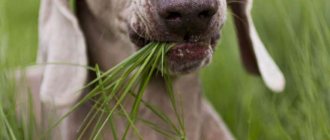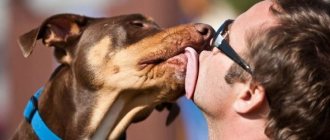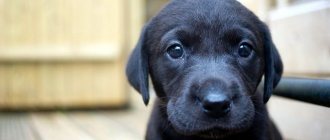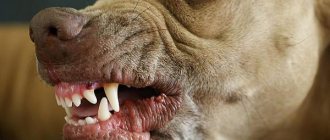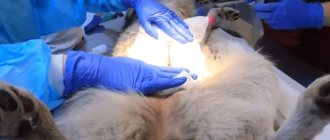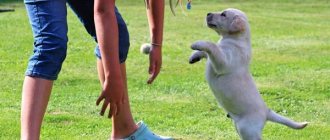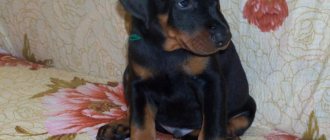Most dog owners have seen their pets eat grass outside. This behavior may seem a little strange to a person who is far from dog breeding. It seems strange that dogs seem to be carnivores, and grass is not part of their daily diet.
Another thing that dog owners have most likely noticed is that after the pet has eaten grass, very often he begins to cough and regurgitate the eaten greens, sometimes along with other foods eaten the day before. This may raise the question of why dogs continue to persist in eating grass even though they have already coughed from it once and felt, at least visually, not very well. So, if you have ever wondered why a dog eats grass and then vomits, then this article is just for you. Today you will find out what causes such a love for grass, and what it gives the dog.
Why does a dog eat grass outside?
Dogs don't like grass so much as they eat it when necessary. They eat mostly wheatgrass, which boasts long, tough leaves. The weed grows not only in parks, forests and meadows, but also on city streets.
What grass does a dog eat if there is no wheatgrass nearby? Pets can eat other plants with hard leaves, incl. sedge, hay. Before swallowing wheatgrass, dogs sniff it and eat it only when they catch the desired smell.
Reason 1. Need for fiber
A dog will eat wheatgrass if its diet is low in fiber. This is the name for dietary fiber, which is not processed in the intestines, but is useful for “good” microflora. Fiber has a good effect on intestinal motility, promoting the release of feces. Therefore, if the body lacks hard fibers, the pet eats grass, which is excreted in the feces.
Reason 2. To cleanse the stomach or intestines
If a dog eats grass and then vomits, it means it needs to cleanse its stomach or intestines. This usually happens when the dog feels unwell, has a stomach ache, ate something wrong and is throwing up.
The hard leaves irritate the stomach and tickle the throat, causing vomiting a few minutes after eating the herb. Sometimes the reaction is delayed and vomiting begins at home. Therefore, you should always have cleaning supplies for dogs on hand.
Sometimes there is no vomiting, and the wheatgrass quickly passes through the digestive tract and exits through the anus, wrapped in mucus. Much to the owner’s surprise, this happens a few minutes after eating the grass, if the dog has emptied before. If not, wheatgrass speeds up the bowel movement process.
Reason 3. Perversion of taste
Sometimes a dog will experience a condition known as “taste perversion.” She has a constant need to eat grass, paper, garbage, feces, and other inedible objects. In this case, the pet must be carefully monitored, otherwise digestive problems may arise - poisoning, intestinal obstruction, worms.
To resolve the issue, take your dog to the doctor. Taste distortion can be caused by poor nutrition. But sometimes the reasons lie deeper and are caused by malfunctions in the brain.
Reason 4. Your pet likes to eat grass.
A dog may eat wheatgrass because he likes the taste and texture. There is nothing wrong with this if there are no signs of illness.
Reason 5. The dog is bored
Another reason why dogs eat grass is because they are bored. This usually happens if the pet is left unattended in the yard for a long time. To keep himself occupied, he chews sticks and other things, and eats grass.
Reason 6. Attracting attention
Dogs crave human communication, and therefore try to attract the owner with various actions, incl. inappropriate. If you do not pay attention to the dog, but react to eating wheatgrass, he may chew it in order to establish contact with the owner.
What to do?
Accidentally eating grass is not a cause for concern. If your dog eats grass out of boredom or lack of nutrients, that's normal! However, it is advisable to monitor such a habit so that the dog does not get poisoned and find out about the puppy’s illness in time.
- Indoor dogs that don't get much exercise can start eating indoor plants to feel closer to nature. This can be dangerous and even fatal, depending on the type of plant. Avoid growing any potentially poisonous plants.
- If you cannot or do not want to avoid growing plants that are toxic to dogs, keep the plants out of your dog's reach. Or train your dog so he knows which plants or areas in your home or garden are off-limits.
- Never allow your dog to eat grass that has been treated with chemicals, as this can lead to poisoning. Even if you don't use herbicides or pesticides on your own lawn and garden, you have no control over your neighbors' actions. Toxic substances can enter your yard through water runoff or wind. This also applies to public areas, such as parks, where the grass is frequently treated.
- Make sure your dog has enough physical and mental activity every day, giving him more attention will combat boredom and prevent grass eating.
- A sudden increase in grass eating may be a sign that your dog is sick or lacking vital nutrients. Pay attention to your dog's actions so you can discuss them with your veterinarian if necessary.
- Review the ingredients in your dog's food to make sure it truly provides a balanced diet with all the nutrients your pet needs. Switching to foods that are higher in fiber or that improve digestion overall may reduce your pup's need for an herbal supplement.
If your dog consistently eats grass for more than two days in a row and vomits every time, this is a sign that you should take your dog to the vet. Chronic indigestion should be checked out as soon as possible to rule out intestinal parasites such as roundworms or something more serious such as parvovirus or kidney disease. It is very important to promptly give your dog (even if not walking) medications against internal and external parasites that will help protect the dog from ticks, helminths and fleas, such as NexgarD Spectra. It is important that the tablet has the taste and smell of beef stew, which makes it easy to feed it to your pet. Immediately after application, you can resume playing and walking with your dog.
RCV-CAN-0244-2021
What plants are dangerous for dogs?
Don't let your dog eat wheatgrass:
- along the highway;
- on a heavily polluted street;
- near a working plant, factory or small enterprise that is engaged in hazardous production.
Walk away from planted fields that are treated with pesticides, fertilizers, and rodent poisons. The grass growing here is dangerous for the dog and can cause poisoning.
If you live in a townhouse and treat the area with pesticides, pay attention to whether the product is safe for pets. Buy high-quality drugs that do not harm dogs, cats, people, or birds.
Don't give your dog indoor plants, even if she wants to eat them. They can be toxic to your pet. First of all, this applies to tulips, daffodils, hyacinths, orchids, azaleas, rhododendron, tiger lilies, and foxgloves. Usually the dog won't eat them, but a puppy or young dog who likes to chew sticks may become interested in the flowers and eat the leaves.
Analogs from a pet store
Sprouted seeds of cereals and other crops are often sold in pet stores. You can be completely confident in the safety of this greenery. And if your pet doesn’t like the grass, you don’t have to throw it away. Transplant it into a larger pot and use it as a decorative element in your home.
The consultants in the store will tell you which greenback will suit your four-legged friend. They will also advise you on this or that plant if your dog has any health problems.
It would be a good idea to buy greens at any supermarket. This is about:
- Celery: Its stalk has anti-inflammatory properties. Indispensable for older pets suffering from arthritis.
- Parsley: it is rich in manganese, phosphorus, calcium, potassium and folic acid, which is very necessary for the health of dogs. Parsley also helps prevent unpleasant odor from an animal's mouth.
- Dill: since dill has a specific taste, animals do not always agree to eat it. But dill helps increase appetite and improve the functioning of the digestive system and kidneys.
- Basil: It contains vitamins B2 and C, potassium, calcium, iron, folic acid and magnesium. Like dill, basil improves digestion and increases appetite. Some feed manufacturers add basil to their products.
Don't give your wet-nose greens unless you're sure he needs them. It is better to discuss this point with your veterinarian. As a useful additive, you can finely chop dill or parsley in small quantities and add it to the food.
What to do to stop your dog from eating grass
If you are concerned about your dog's health when he eats wheatgrass, do the following:
- Review your dog's diet, paying special attention to fiber. Many dog owners have found that their pet stops eating grass when they include vegetables and fruits (cabbage, apples, carrots) in their diet.
- Feed only high-quality food that is beneficial to animals and easily digestible. If the dog is natural, the diet should consist of meat, vegetables, and fruits. When she eats dry food, buy a super premium or holistic product. Never feed economy class food.
- Raw, unpeeled beef stomach (tripe), which contains a huge amount of enzymes that improve digestion, is beneficial for your dog.
- Don't give food from the table or leftovers that you haven't eaten.
- If your dog eats grass out of boredom, play with him and buy toys.
- When walking, pay attention to your pet, not your smartphone.
- Monitor your pet's health.
Herbal medicine for four-legged animals
Not only people are treated with herbs - they are ideal as a gentle therapy for dogs. In some cases, herbs can help faster and more effectively than medications. However, the appropriateness of such treatment must be confirmed by a veterinarian. If a four-legged animal is diagnosed with a serious illness, then traditional medicine fades into the background.
Non-dangerous sores can easily be cured with herbs, but only if you are sure that they will help your animal. Under no circumstances should you give plants that you are not sure are safe. If some infusion or mixture helped you, this does not mean that it will help your dog.
If your pet loves to eat street vegetation, try to walk it away from the roads. It will be much better if you start growing greenflies for your pet yourself. At least you will be sure that it is clean and safe, and if the dog is used to eating grass outside, he will probably stop doing it.
Should you take your dog to the vet?
If your dog eats grass from time to time, this is normal. But if she does this constantly, it is better to consult a doctor, as she may be talking about digestive problems or other diseases. You should be especially wary if, in the absence of grass, in an attempt to induce vomiting, the dog tears and eats paper and pieces of fabric.
If your dog isn't showing any symptoms but you think he's eating too much grass, let him fast for a day. If your pet continues to eat wheatgrass, go to the vet.
See a doctor immediately if your dog not only eats grass, but also has the following symptoms:
- diarrhea;
- vomit;
- weight loss;
- loss of appetite;
- blood in stool;
- frequent licking of lips;
- lethargy.
These signs may indicate various problems, including serious infectious diseases and poisoning. The doctor will make a diagnosis based on blood and urine tests. X-rays and other examinations may be needed.
Dogs are real predators
Naturally, dogs eat meat; moreover, it should form the basis of their diet. Despite this, dogs are not considered predators in the strict sense of the word. They are best classified as omnivores (that is, animals that eat both meat and plant foods). It's no secret that dogs, in principle, eat almost everything. Dogs do eat a wide variety of foods, including plants and vegetables. Of course, such an explanation is not enough, especially since it does not reveal the reasons why dogs regurgitate the grass they eat. Let's look at the main nuances of this issue.
Benefits for the body
Eating a bunch of grass is also useful for combating constipation. An inactive lifestyle and an unbalanced diet can cause difficulties with bowel movements. The large amount of fiber and moisture contained in eaten greens helps cleanse the intestines.
From the stomach, unprocessed grass enters the intestines, swells and moves feces towards the exit.
When a pet eats grass and burps, in addition to the dangerous contents of the stomach, it also gets rid of excess bile. In this way, its stagnation in the body is prevented.
By observing during a walk, you can notice what grass dogs eat most often and what they prefer. This:
- meadow grasses with hard leaves - wheatgrass, bluegrass, sow thistle;
- cereals - oats or wheat;
- vegetable leaves - beets, carrots, lettuce, nettles;
- the heads of some flowers are cornflower or calendula.
Some breeds - wolfhounds, Samoyeds, Malamutes - are able to find medicinal plants. They dig up Jerusalem artichoke, valerian roots, tear and eat clover heads.
However, it should be remembered that there are also poisonous plants. They can get into a dog’s mouth at home, on the street or in their garden.
Precautionary measures
Indoor flowers such as dieffenbachia, monstera, and oleander contain calcium oxalates, needle-like formations on the stems, and extremely poisonous juice. Upon contact with mucous membranes, they cause a burning sensation, pain, and vomiting. If the poisonous oleander juice gets into the dog's digestive tract, it may die.
Dangerous flowers should be kept completely out of reach of your pet.
On a personal plot, a dog can also be in danger. Garden crops are fertilized and sprayed against pests.
At the dacha, you need to carefully monitor your pet; it is better to block his access to the garden beds to avoid poisoning.
While walking in the city or in the park, you can also come across a clearing treated with insecticides. Also, the leaves may contain eggs of worms or parasites, which can cause severe infectious diseases.
You should not allow your pet to chew grass that grows near highways. There is a high concentration of toxic substances from exhaust gases.
It is necessary to regularly carry out prevention against worms. Along with the grass you eat, there is a high probability that parasite eggs will enter your body.
What grass can an animal eat?
If your pet chews grass, you should carefully choose walking areas. There should be no roads nearby: heavy metals from machine exhausts settle on the vegetation, causing harm to health. The dog can catch an infection and become infected with helminths (worms).
Allow people to eat grass outside the city after receiving the necessary vaccinations.
The most beneficial for dogs are:
- wild cereals (wheatgrass, sow thistle);
- oats or wheat;
- special greens for cats that dogs eat with pleasure;
- carrot tops, beets, chamomile, dill, parsley and others.
They are not mixed with food, but given as a separate treat.
It is recommended to buy seeds in a store and grow them at home. In just three weeks you can pamper your pet with an environmentally friendly product. Consultants will tell you what is best to buy to keep your puppy healthy and happy.
Popular Misconceptions
Why do dogs eat grass and should they be allowed to do so? After all, they are carnivores, they are supposed to eat meat.
The most common opinion is that the pet dog eats greens to compensate for the deficiency of vitamins in the body. But why then does a dog that receives nutritious, balanced food also sometimes eat grass with pleasure? In fact, even young spring greens are not able to bring any benefit to a dog with their vitamin composition. The digestive system of predators is designed in such a way that their stomach cannot digest grass. They simply do not produce the enzymes necessary to break down such food.
Another assumption is that the dog brushes its teeth in this way and eliminates the smell from its mouth. The jaw of predators is designed in such a way that thin blades of grass simply slip between the teeth. Dogs' teeth are excellent for gnawing and tearing pieces of meat, but not for chewing grass. Therefore, this process also does not affect the cleanliness of teeth.
When to sound the alarm
Which dog matches a person's zodiac sign?
Animals often try to eat dandelions or celandine. If you can give the first ones without fear, then celandine should be completely excluded. It is not even possible for it to grow near the dog’s place of residence. This is a poisonous plant. Immediately after consumption, harm may not appear, but after some time the animal will become lethargic, refuse food, and may begin to drip saliva from its mouth or vomit. In this case, you should immediately go to the veterinarian so that he can provide the necessary assistance to your pet in a timely manner.
Take care of your dog's health - become a gardener
Dogs are capable of trying to replace grass in ways available to them. They may eat plastic bags or strings. These substitutes are dangerous as they can cause volvulus or other mechanical damage. It is necessary to provide the pet with the opportunity to find the necessary greenery. At the same time, it is better to walk in clean grassy areas, away from highways and walking areas of other pets.
If this is not possible, you can give the dogs your own grass. Pet stores offer a large selection of grass seeds for pets. Within two weeks after planting, sprouts will appear. It will be possible to supplement your pet’s diet without any health concerns.
Owners who feed their dogs the wrong, poorly balanced food should review the menu. If your diet contains a lot of carbohydrates, you need to reduce their volume to 20% of your total daily diet. At the same time, you need to increase the intake of proteins. They should be up to 50-70% and come mainly with meat.
Allow or deny?
Even experts do not agree on this issue, but I will say based on my personal experience. Of course, allow it. Although there is no benefit from eating grass, because dogs are predators and are not able to digest fully plant foods, it does not cause any particular harm.
The dog knows better what he needs because he feels his body. In addition, this will allow you to track the onset of a serious illness if other symptoms suddenly appear. The main thing is to make sure that the dog does not eat any poison.
Experts also recommend growing a mini herb garden at home for such purposes. Dogs are especially not indifferent to grasses such as wheatgrass, sprouted rye, wheat or oats. This will keep your nervous system in order, because a home garden will allow you not to worry that your dog will accidentally eat poisonous grass or a chemical that is used to treat plants.
Diet is a reliable assistant in the treatment of diarrhea
Treatment of diarrhea resulting from poor diet or malnutrition, as well as disruptions in the gastrointestinal tract, is impossible without proper nutritional correction.
If you adhere to the basic principles of a diet for diarrhea, the problem can be solved much faster, and at the same time will serve as a prevention of possible intestinal dysfunction.
Here are some simple diet rules for diarrhea:
- the load on the digestive organs during diarrhea should be minimal (food should be consumed crushed and boiled);
- You should eat foods high in pectin, potassium and protein, for example, bananas, applesauce, fruit juices, bananas, beef, turkey, chicken.
- in the first days you should eat only liquid food and gradually switch to your usual diet, introducing foods as the frequency of loose stools decreases6;
- food intake should be fractional, in small portions 5-6 times a day.
It is important to remember that prolonged, exhausting loose stools are a reason for immediate consultation with a specialist.
Option 2
Prishvin’s story “The Pantry of the Sun” tells about the fate of two little orphans, in whose lives Travka, one of the characters in the story, played a big role.
Travka is a former dog of a forest ranger who lived with him in the forest. A smart, learned dog, she understood her owner well and went hunting with him. After the death of its owner, the dog was left alone, but it did not want to leave the habitable place where it lived so happily with the forester, and continued to live in the forest.
Over time, the forester's hut fell apart, but Grass was still in no hurry to leave the forest. She continued to hunt small game and, out of habit, brought her prey to the collapsed hut. Then she realized that the owner was no longer there, and her prey was her food. The dog missed its owner very much, and when it became completely sad alone, Grass began to howl. This is how she expressed her love and devotion to her owner, her sadness and longing.
One day Travka, hearing a hare, went hunting for him. The hare confused his tracks, and the Grass either lost his scent, then found it again. Suddenly she jumped out into a swampy swamp and saw a boy in it. The dog stopped and began to wonder whether it was the owner or not. She stood and looked at him, when suddenly the boy called her name. The grass was very happy; it recognized him as its owner. But the boy spoke to her sternly, and she did not throw herself on his shoulders, but only began to crawl little by little. She didn't yet know what to expect from him. And the boy did this on purpose: if he had spoken to her kindly, the dog would have rushed to him, and they both would have drowned in the swamp.
The grass crawled towards the boy, and then he grabbed it by the paw, and then by the other. Out of surprise, the dog jerked and pulled the boy out of the swamp. At this point he himself, with the help of a gun, was able to get to a safe place. So Travka saved the boy’s life and found a new owner. A wolf came running in response to her barking, the boy shot him with a gun, and Mitrashi’s sister came running. Everyone was very glad that everything ended so well, and the dog Travka went with the children to the village, recognizing Mitrasha as the owner. But the hare, which Grass was chasing, remained alive and ran away to his forest.


